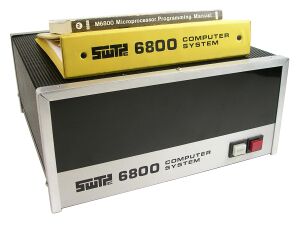Engineering:SWTPC 6800
 | |
 | |
| Developer | Southwest Technical Products Corporation (SWTPC) |
|---|---|
| Manufacturer | SWTPC |
| Release date | November 1975 |
| Introductory price | US$450 (equivalent to $2,100 in 2019) |
| CPU | Motorola 6800 |
| Memory | 4 KB (stock) |
| Graphics | ASCII terminal output |
| Dimensions | 6.75 by 15 by 15.375 inches (17.15 cm × 38.10 cm × 39.05 cm) |
The SWTPC 6800 Computer System, simply referred to as SWTPC 6800, is an early microcomputer developed by the Southwest Technical Products Corporation and introduced in 1975. Built around the Motorola 6800 microprocessor from which it gets its name, the SWTPC 6800 was one of the first microcomputers based around that microprocessor.[1] It is the progenitor of the widely used and broadly supported SS-50 bus. The SWTPC 6800 became one of the most popular 6800-based systems of its time, owing to its ease of use and ample documentation. Though rudimentary, the MIKBUG resident monitor built into ROM allows the immediate entry of program data after power-up, as opposed to other microcomputers of its day which required bootstrapping such software. Southwest Technical Products introduced the SWTPC 6800 in November 1975 for US$450 (equivalent to $2,100 in 2019) in kit form only. Any contemporary ASCII terminal can be used to interface with the SWTPC 6800.[2] SWTPC sold their own television-set-based terminal, for $275; a crude dot-matrix printer was another optional accessory, for $250.[1]
Southwest Technical Products followed up the 6800 with the S/09 in 1979 and the 69/K, 69/A, and 69/56 in 1980. All four replaced the Motorola 6800 processor of the original with its successor the 6809. The SWTPC 6800 can be converted to a S/09 with a system board kit sold by Southwest Technical Products, which is also compatible with existing 6800 peripherals and cards; while the 69/K, 69/A, and 69/56 features a redesigned system board and chassis that is incompatible with the 6800. The 69/K was sold as a kit, while the 69/A and 69/56 came pre-assembled (the latter featuring 56 KB of RAM as opposed to the 69/A's 8 KB).[3][4][5]
Specifications
| Date introduced | Microprocessor | Clock speed (kHz) |
Stock RAM size (KB), width |
Dimensions |
|---|---|---|---|---|
| 1975 | Motorola 6800 | 980 | 4 KB, 8-bit | 6.75 by 15 by 15.375 inches (17.15 cm × 38.10 cm × 39.05 cm) |
See also
- Chieftain, a clone by Smoke Signal Broadcasting
- FLEX (operating system)
References
- ↑ 1.0 1.1 Miller, Leslie (June 27, 1995). "Loyal users cling to comfortable old computers". USA Today (Gannett Company): 4D. https://www.proquest.com/docview/306716342/.
- ↑ Nadeau, Michael (2002). Collectible Microcomputers. Schiffer Book for Collectors (Illustrated ed.). Schiffer Publishing. p. 122. ISBN 9780764316005. https://archive.org/details/collectiblemicro0000nade/page/128/.
- ↑ "The World's Most Powerful 8-bit Microcomputer" (Advertisement). Personal Computer World (Intra Press) 2 (3): 80. July 1979. https://archive.org/details/PersonalComputerWorld1979-07/page/80/.
- ↑ Stark, Peter A. (July 1980). "Thoughts on the SWTP Computer System". Kilobaud Microcomputing: 100–108. https://archive.org/details/kilobaudmagazine-1980-07/page/n101/.
- ↑ "We Have a 6809 for You" (Advertisement). Byte (McGraw-Hill) 5 (2): i. February 1980. https://archive.org/details/byte-magazine-1980-02/page/n1/.
- ↑ "SWTPC 6800 Computer". The Centre for Computing History. 2012. Archived from the original on May 8, 2022. https://web.archive.org/web/20220508111739/https://www.computinghistory.org.uk/det/16739/SWTPC-6800/.
External links
 |


